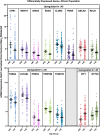Using publicly available datasets to identify population-based transcriptomic landscape contributing to the aggressiveness of breast cancer in young women
- PMID: 36685821
- PMCID: PMC9845274
- DOI: 10.3389/fgene.2022.1039037
Using publicly available datasets to identify population-based transcriptomic landscape contributing to the aggressiveness of breast cancer in young women
Abstract
Introduction: Although the risk of breast cancer increases with advancing age, some regions have larger number of young breast cancer patients (≤45 years-old), such as the Middle East, Eastern Asia, and North Africa, with more aggressive and poorly differentiated tumors. We aimed to conduct an in-silico analysis in an attempt to understand the aggressive nature of early-onset breast cancer, and to identify potential drivers of early-onset breast cancer using gene expression profiling datasets in a population-dependent manner. Methods: Functional genomics experiments data were acquired from cBioPortal database for cancer genomics, followed by the stratification of patients based on the age at representation of breast cancer and race. Differential gene expression analysis and gene amplification status analysis were carried out, followed by hub gene, transcription factor, and signalling pathway identification. Results: PAM50 subtype analysis revealed that young patients (≤45 years-old) had four-fold more basal tumors and worst progression-free survival (median of 101 months), compared with the 45-65 years group (median of 168 months). Fourteen genes were amplified in more than 14% of patients with an early-onset breast cancer. Interestingly, FREM2, LINC00332, and LINC00366 were exclusively amplified in younger patients. Gene expression data from three different populations (Asian, White, and African) revealed a unique transcriptomic profile of young patients, which was also reflected on the PAM50 subtype analysis. Our data indicates a higher tendency of young African patients to develop basal tumors, while young Asian patients are more prone to developing Luminal A tumors. Most genes that were found to be upregulated in younger patients are involved in important signaling pathways that promote cancer progression and metastasis, such as MAPK pathway, Reelin pathway and the PI3K/Akt pathway. Conclusion: This study provides strong evidence that the molecular profile of tumors derived from young breast cancer patients of different populations is unique and may explain the aggressiveness of these tumors, stressing the need to conduct population- based multi-omic analyses to identify the potential drivers for tumorigenesis and molecular profiles of young breast cancer patients.
Keywords: aggressive; amplification; breast cancer; early-onset; genomics; in-silico; metastasis; transcriptomics.
Copyright © 2023 Tabbal, Hachim, Jan and Adrian.
Conflict of interest statement
The authors declare that the research was conducted in the absence of any commercial or financial relationships that could be construed as a potential conflict of interest.
Figures













Similar articles
-
Age-specific gene expression signatures for breast tumors and cross-species conserved potential cancer progression markers in young women.PLoS One. 2013 May 21;8(5):e63204. doi: 10.1371/journal.pone.0063204. Print 2013. PLoS One. 2013. PMID: 23704896 Free PMC article.
-
Intrinsic subtypes from PAM50 gene expression assay in a population-based breast cancer cohort: differences by age, race, and tumor characteristics.Cancer Epidemiol Biomarkers Prev. 2014 May;23(5):714-24. doi: 10.1158/1055-9965.EPI-13-1023. Epub 2014 Feb 12. Cancer Epidemiol Biomarkers Prev. 2014. PMID: 24521995 Free PMC article.
-
The Transcriptomic Portrait of Locally Advanced Breast Cancer and Its Prognostic Value in a Multi-Country Cohort of Latin American Patients.Front Oncol. 2022 Mar 22;12:835626. doi: 10.3389/fonc.2022.835626. eCollection 2022. Front Oncol. 2022. PMID: 35433488 Free PMC article.
-
Breast cancer under age 40: a different approach.Curr Treat Options Oncol. 2015 Apr;16(4):16. doi: 10.1007/s11864-015-0334-8. Curr Treat Options Oncol. 2015. PMID: 25796377 Review.
-
Genetic alterations in the phosphatidylinositol-3 kinase/Akt pathway in thyroid cancer.Thyroid. 2010 Jul;20(7):697-706. doi: 10.1089/thy.2010.1646. Thyroid. 2010. PMID: 20578891 Free PMC article. Review.
Cited by
-
Identification of Breast Cancer LCK Proto-Oncogene as a Master Regulator of TNBC Neutrophil Enrichment and Polarization.Int J Mol Sci. 2023 Aug 26;24(17):13269. doi: 10.3390/ijms241713269. Int J Mol Sci. 2023. PMID: 37686072 Free PMC article.
References
-
- Azim H. A., Nguyen B., Brohee S., Piccart-Gebhart M. J., Sotiriou C. (2015). The pattern of somatic mutations and chromosomal copy number variations (CNV) in young breast cancer (BC) patients (pts). J. Clin. Oncol. 33 (15), 579. 10.1200/jco.2015.33.15_suppl.579 - DOI
-
- Bartel C. A., Junk D. J., Jackson M. W. (2017). Abstract 1975: FAM83B: A novel regulator of cell plasticity in breast cancer. Cancer Res. 77, 1975. 10.1158/1538-7445.am2017-1975 - DOI
LinkOut - more resources
Full Text Sources

